
Yes, where do you go if you have 14 days to spare and have read all of the Inspector Dupin crime novels over the last winter…if you want to have a bit of the sea…if you want to follow in the footsteps of King Arthur, Merlin and Fairies, if you want to see where Asterix and Obelix lived, if you want to eat original buckwheat crepes and are not afraid of a loooong journey in a diesel carriage?
Exactly – Brittany, or French Bretagne, or Breton Breizh, or Gollo Bertaèyn / Bertègn or Little Britain, as the Anglo-Saxons say… a former independent kingdom on the Atlantic coast, surrounded by the British Isles and part of France since 1532.
Brittany is the most western peninsula located in in the north west of the main land of France. It consists of 4 departments (Côtes-d’Armor, Finistère, Ille-et-Vilaine, Morbihan) and is with 27.000 sqkm the third largest region in France. This trip will focus on the following seven cities
The Journey
Almost 3.500km from the greater Munich area to Brittany and back. Driving with a van 300km per day is a good number as there is usually a mix between motorway and country roads. If driving only motorway up to 500km per day is an o.k. distance. Beyond that it’s rather exhausting and does not add to the fun and recreation one seeks during a vacation.

So, in order to spend as much time in Brittany the driving was optimised to maximum amount of motorway time and in France that means Péage.
And there something new in France – Péage without stop and they call it flux libre.
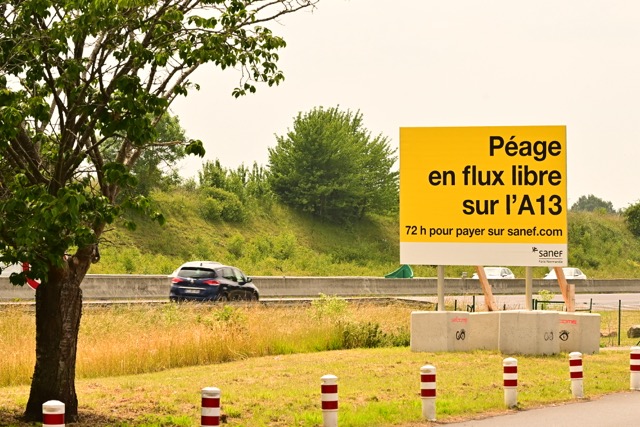
Remember in the old days where Péage stations were almost like border crossings? You had to stop, pull a ticket, then you drove a bit until you hit Péage station and a real person smoking a Gaulois took your ticket and told you how much to pay. In those days it was still in French Francs. Later people were replaced by “vending machines” where you just threw in the coins to clear your passage. Then credit card payment was added, but there was always that adrenaline kick when the two-lane motorway opened to the thirty-six Péage booths. Who doesn’t fondly remember the frantic fumbling for change and the arguments when a franc was missing? That’s all gone now…at least on the A4, A69, A79, A412 and A13/14. Welcome in the new era.
You still have to pay, but online and you have to care of it by yourself. There is nobody, no email that gives you a nudge. This usually can’t wait until you return from vacation, because payment is due within 72 hours after consumption of motorway.


This means that just as you need a credit card to fill up at most motorway gas stations, you now also need internet access, an internet-enabled device, and a credit card to pay the toll.
The website stated that it could take up to 24 hours for the payment information to be available…72-24, meaning you’d have two days to pay at the shortest possible time. The A13 motorway from Paris to Caen in Normandy was smooth and cost €27.20. In my case everything worked fine.
Saint Malo

From Caen, the journey continues without a Péage on the motorway and the Route National, past Saint-Mont-Michelle to Saint Malo.
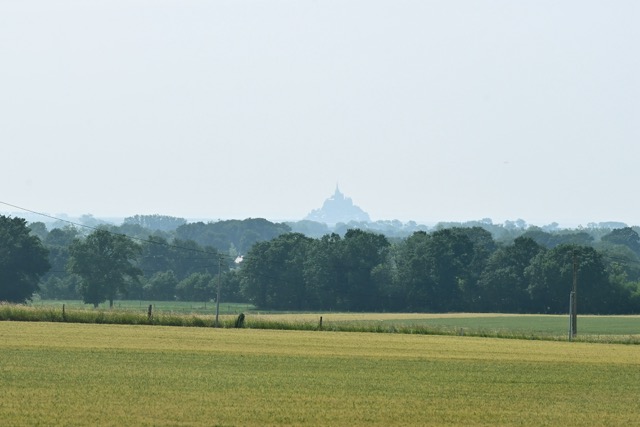
In Saint Malon, the nearest campsite is in La Cité d’Alet, a district of Saint-Malo. La Cité d’Alet offers magnificent views of the Rance estuary, and directly above the campsite is the Forth de la Cié Aleth which was built 1759. In the second world war additional bunkers and six-port turrets were added.

A relict from Second World War, a six-port turrets
The harbour of La Cité d’Alet is home to many privat boots as well as start and end point for ferries to and from Plymouth, Portmouth, and Saint Helier in Jersey. One of the welcoming and farewell rituals is blowing the ship’s horn, so that everyone within a 50-km radius is properly informed.



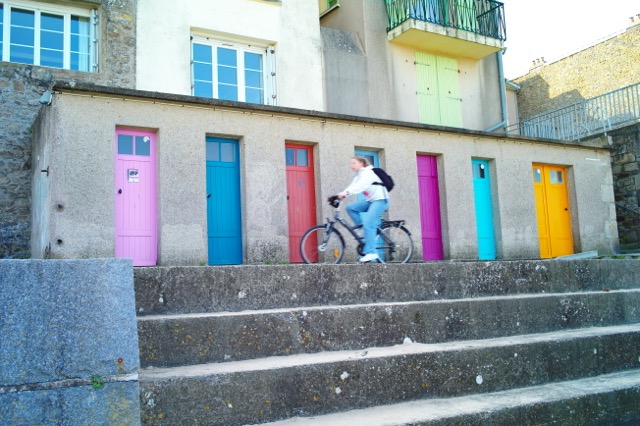

Saint-Cast-le-Guildo

Continuing west, the route crosses a bridge between La Madeleine and La Gougeonnais, which also houses a tidal power plant. Since 1967, the plant has been harnessing the approximately 8-meter tidal range from the Atlantic Ocean to feed electricity into the grid, making it the world’s first commercially used tidal power plant.
Above Saint-Cast-Le-Guildo there is a parking lot from which you have a very nice view of the harbour. Even though the Emerald Coast begins in Saint Malon, the colours are nowhere near as intense as, for example, in Saint-Cast-Le-Guildo or the Bay of Portà la Duc.



There are a few very picturesque beaches with gorges green water which gave this part of Brittany the name smaragd coast line.




The tides change approximately every six hours. Oyster farmers aren’t the only ones who take advantage of the low tide here in the bay between Saint-Cast-le-Guildo and Château de la Roche Goyon. Brittany has one of the highest tidal ranges in Europe.



This creates nutrient-rich and oxygen-rich water, which is essential for oyster farming. The strong currents and clean, cold water contribute to the production of firm, flavorful oysters. The cultivation of flat oysters, especially the “belon,” plays an important role in Breton culture and gastronomy.
Trégastel

Made a brief stop in Trégastel on the way to Saint-Pol-de-Leon via the N12 and D767, where people were cultivating a rock garden of a different kind.

Above the Plage de la Grève Blanche, which is part of the Granit Rose, lies the “Crown of King Gradlon.” A rock that, from the sea, suggests a sharp-edged male head. Of course, you can’t see it from above, but the rock from above is worth seeing, along with the view of the beach.




Saint-Pol-deLeon
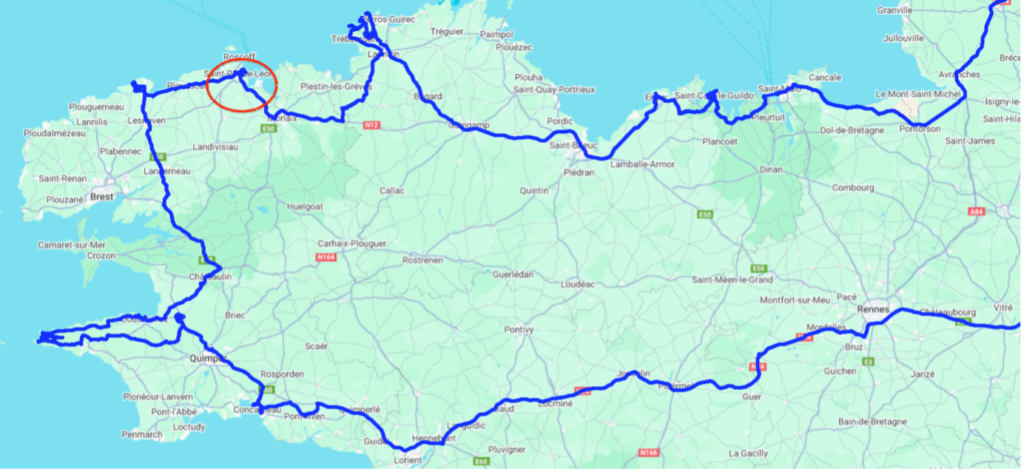
On the way to Saint-Pol-de-Léon made a short stop in Kerlouan, a picturesque coastal village known for its traditional stone cottages, and pristine beaches.

One of its main attractions is the village of Meneham, a restored 18th-century hamlet nestled among dramatic granite rock formations.
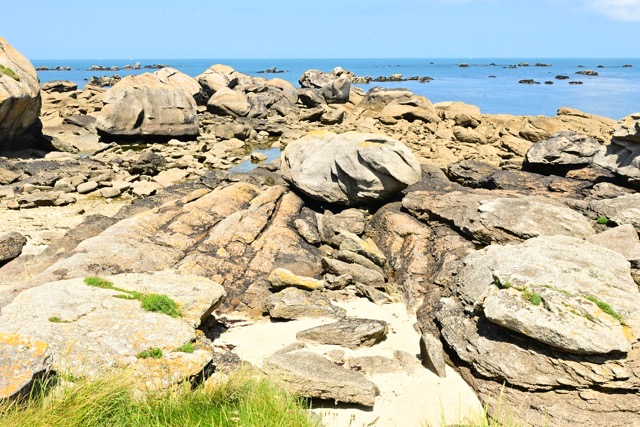
Originally built as a lookout post to guard against naval invasions and smuggling, Meneham later became a fishing and farming community.

Saint-Pol-de-Léon is a former bishopric. The church, built between the 13th and 16th centuries on the foundations of a Romanesque Basilica, gives you an idea of what Saint-Pol-de-Léon used to be like.





The cathedral marks the centre of the town and is dedicated to St. Paulinus Aurelianus (also called Paul of Leon), one of the seven more or less legendary founding bishops of Brittany… not the St. Paul from Tarsus (former Saulus).


I appreciate the tradition of naming Beer after Monks, Priest and Saints.


Point du Raz

Plogott is located in the Finistère department. The Romans named this place at the tip of the Breton peninsula Finis Terrae (End of the Earth). Interestingly, the Breton name is Penn ar Bed, which means “beginning, tip, or head of the world.” At the Ponte du Raz, the end of the world.






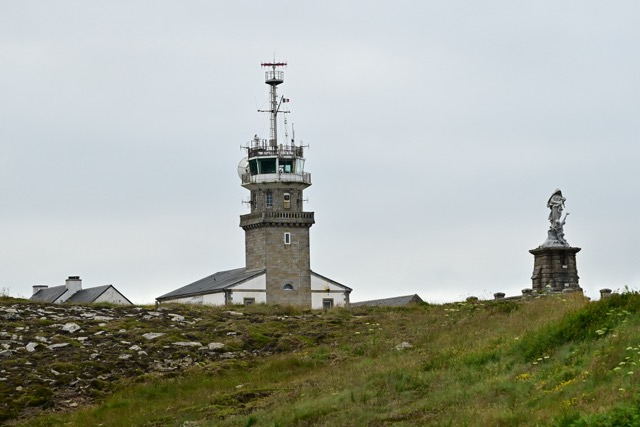
Driving along the D607 will bring you to the beautiful the Plage de la Baie des Trèpassés, a breathtaking beach nestled between the famous Pointe du Raz and Pointe du Van on Brittany’s wild Cap Sizun coast. Being such a stunning place, it is part of the “Grand Site de France,”.

The name derives from the Breton legends—either from “Bae an Anaon” (Bay of Souls), referencing shipwrecked souls washed ashore, or a mistranslation of “avon” (river). A myth states that there was a druidic tradition where they set sails from here to the Île de Sein, an island roughly 3 km into the Atlantic.


And the best thing for Alfa, dogs are allowed on the beach.

Locronan


The town of Locronan is a beautifully preserved medieval town renowned for its rich history and charming architecture. Designated as one of “Les Plus Beaux Villages de France”, it has cobbled streets, granite houses from the 15th and 16th centuries and a central square dominated by the stunning Saint-Ronan Church, built in the late Gothic style.



The town is named after Saint Ronan, an Irish missionary. Surrounded by lush countryside and near the Bay of Douarnenez, Locronan is also a haven for artists and filmmakers due to its timeless beauty and authentic atmosphere. It offers a peaceful, pedestrian-friendly experience with local artisan shops, galleries, and traditional Breton cuisine.Every six years, it hosts the Grande Troménie, a 12km pilgrimage that attracts thousands. Next one is on second and third of July 2025.



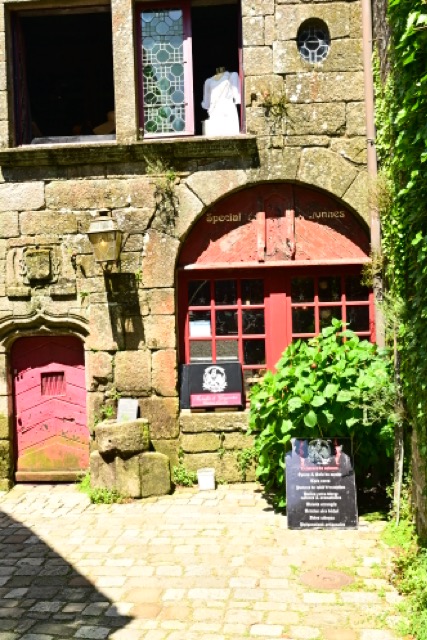

Impressions from Locronan
Locronan was historically a centre for sailcloth production, contributing to its prosperity during the Age of Sail. The high quality of the sailcloth was also appreciated by the Spanish Armada. Today the main business is with the 500.00 to 800.000 tourists every year.
Concarneau


Concarneau is a captivating coastal town in Brittany, split between a lively modern port and the iconic Ville Close, a fortified medieval island-town from the 14th–16th centuries which can be accesses via a drawbridge. As common in Brittany the old part of the city presents itself with cobblestone, the typical stone houses and narrow streets.
Beyond the walls, the active fishing harbour is Europe’s top tuna port and France’s third-largest fresh‑fish market.


The fishery port is critically important—it’s Europe’s leading tuna port and France’s third-largest fresh-fish market—with over 200 fishing vessels. The daily fish auction (criee) is a lively event in the “Les Halles”.
In the marina private and military ships share the place.
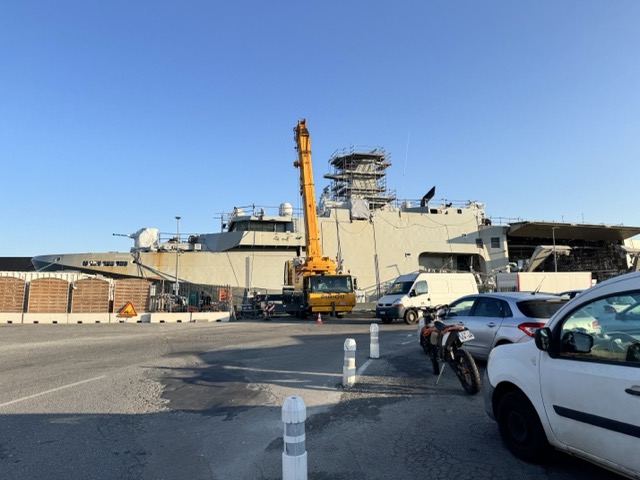



Cultural heritage thrives through the Fête des Filets Bleus, a summer festival celebrating Breton and Celtic culture. The name “Filets Bleus” (Blue Nets) refers to the blue nets used by fishermen in Concarneau and is a symbol of the festival’s close connection with the town’s maritime history and culture. It was originally created to help families in need, especially those who depended on sardine fishing. Dating back to 1905, it honours fishermen with parades, music, traditional dance, and a queen’s election. Every July, the Vieilles Coques gathering draws classic sailing vessels and maritime enthusiasts.




Analoge Pictures
Here a few analoge pictures taken with a Hasselblad 501CM with a
Carl Zeiss Planar 80mm






